Published on Jun 05, 2023
Cylinder Deactivation
With alternatives to petrol engine being announced ever so often, we could be forgiven for thinking that the old favorite, the petrol engine, is on its last legs. But nothing could be further from the truth and the possibilities for developing the petrol engine are endless.
One of the most crucial jobs on the agenda is to find ways of reducing fuel consumptions, cutting emissions of the green house gas, co2, and also the toxic emissions which threaten air quality. One such fast emerging technology is cylinder deactivation.
CYLINDER DEACTIVATION
2.1 CONSIDERING DAIMLER CHRYSLER
By considering Daimler Chrysler's new 300cc car's powered by a revival of one of the greatest muscle car engine of all time, the V8 Hemi. This third generation grand master of funk has a capacity of 5.7litres snorts out 340 bhp with 54kgm torque and like all Hemis since the early 1950's has a pushrod valve train rather than a over head cam setup. But even though this Hemi can match its forebears on power 'its thirst for fuel has been cut by 10 to 20%. It is done by Chrysler's new multi displacement system (mds).
When using a lot of power, such as during acceleration, the hemi fires on all eight cylinders as usual. But around town or when cruising -even at motor way speeds or under gentle acceleration-the engine switches to frugal four cylinder mode.
Multi displacement system (mds) is activated at part throttle between 1000 rpm and 3000 rpm, when a hydraulically actuated catch in the special valve lifters trips to prevent the valves from opening. Hot gases are trapped in four of the eight cylinders, compressing and expanding like giant air springs as the engine turns over and keeping the cylinder warm. But as long as the valves remain closed, only four cylinders consume fuel instead of eight.
Engine efficiency is also improved because the four dormant cylinders are no longer working hard at sucking air into the engine, something that consumes a substantial amount of power. Although the average fuel saving is 10% ,under certain conditions it is a huge 20%.The transition from eight cylinders to four cylinders happens in just 40 mille seconds under the control of sophisticated engine management software which controls not just the multidisplacement system but also a drive-by-wire throttle.
CONSIDERING HONDA
IN Japan the 3.0 liter I-VTEC (intelligent VTEC) V6 of the Honda inspire can also deactivate tree of its first cylinders refinement being guaranteed by active hydraulic engine mounts to cancel out any vibration and active noise control with in the cabin to neutralize any unwanted booming. Honda's CIVIC IMA hybrid also make use of V TEC to deactivate three cylinders on the over run-again to reduce the pumping losses and cut fuel consumption.
CONSIDERING GENERAL MOTORS
The actual idea of cylinder deactivation is not new. General Motors tried it in 1981 with the V-8-6-4 engine but through lack of sophisticated electronics drivability was awful. Now GM is returning to the idea again and is to soon launch Displacement on Demand (DOD} on itsVortecV 8's improving consumption by between 6 and 8%.

Related Seminar Topics
- 3d Machine Vision Systems
- Aerodynamics of Race Car
- Aeroplane Propulsion System
- Aerodynamics of Race Car
- Air Muscles
- Air Powered Cars